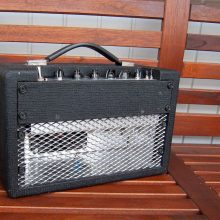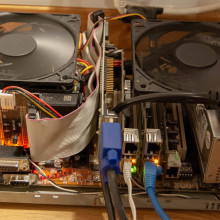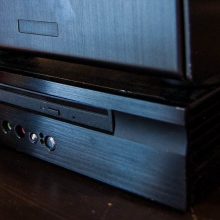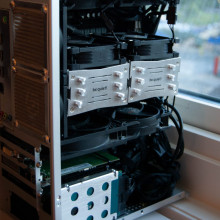Here you’ll find a collection of things that I do, make, say and think. A collection of projects I publshare on other sites online. Including; custom built and designed guitar or Hi-Fi amplifiers and effects, custom PC servers, and rescued, upcycled hardware. Simply a central place to collect what I’m doing with some of my a creative rest at any given time.
If you are in search for my professional information go to >JohannesJohansson.com<
For multiple ways to contact me this >linktree< makes it easy.
Categories
- DIY (23)
- DIY Audio (12)
- DIY Computation (7)
- DIY Misc (5)
Random Posts
-

Restomod Car: 2 Brakes and Suspension
Completely changing the suspension and brakes with oversized parts on this little car can make for a very fun ride and good companion to a […]
-

Restomod Car: 3 GTE Digital Dash start
Digital dash, yes you saw right there is a digital dash available (from an Opel GTE) for this 90’s car, here I will heavily modify […]
-

Dumble Overdrive Special: 1 Head & circuit
The Dumble amplifiers are clearly the highest priced guitar amplifiers ever to exist, and with good, or at least understandable, reason. These amplifiers fetch more […]
-

TrainWreck Rockette: 1 Redesigned
The trainwreck rocket is a highly coveted and copied guitar amp, however it, in part, is a copy itself. It is the core of a […]
-

Headphone repair
When headphones wear out it’s not unusual to effect the soft fabric parts only, so can eb saved by replacement, or you can prevent failure […]





Homelab: 3 Turning laptops into mini-servers
One of the most common e-waste sources out there is laptops, slower than other computers and often not upgradable, lacking ability to change peripherals, like screens. A sad fact as the vast majority of people do rarely use the full potential of the computers of today anyway, often unnecessary upgrading due to lack of awareness of choosing options that allow changing batteries, or keeping software and OS from slowing the machine down.
But when they really get old, they still are more than potent enough for a range of tasks. As an example I am currently running two laptops turned into servers, one about a decade old, the other quite old at two plus decades.
This second one is more interesting, and capable. As laptops have gotten slimmer, many using the ‘Ultrabook’ nomenclature contain quite minimal motherboards. In this they are a good candidate for even smaller servers, tagged to a wall next a router for instance.
Using a fittingly sized case, yet more salvaged heatsinks, some screws and tools a usable mini server is the result. Keeping it cool another left over fan controller easily fits, although connections for the previous cpufan would allow for automated temperature control. Instead having manual adjustment and a silent noctua fan have their own merits.
This one has an interesting task, much like the previous use case providing a standalone service, should the main one fail, this will provide automated fail-over for virtualized machines. Given its capabilities, it runs proxmox, a hypervisor of virtualized computers providing various tasks such as webservers. That means they are configured to automatically stay up to date, a mirroring of an instance running on a more powerful machine and service. However, should the main server go offline, for upgrades, maintenance, or due to an error, the Web addresses and links automatically redirect to the virtual services on this little thing. Hardly up to the same standards it is still plenty fast to deliver and support a number of reasonable pages and functions in the short time.
Starting with the sad remaining innards of a HP spectre laptop, first thing is cooling since the goal is as silent as possible. This relies on not having thrown out other parts.. And I do have some suitable heatsink that can be both bonded with Conductive glue or ‘pads’ and then zip ties for good measure.
To this I opted for a manual fan controller, something easily put together from a few leftovers, ended up with a different controller and fan than in these images (noctua really is unique in low noise applications). For a secure mount I use standoffs, after a fashion, using lots and lots of screws, nuts and washers, and a few more zip ties.
Preserving the added USB and fan header on the daughter board and fitting the fan was tricky but ended up a very nice match with the chassis.
Here I tagged on power for the fan controller and added a badly matched cmos battery. In the end ‘great success’. After testing the virtual machines running on proxmox, and writing some code, they quickly and easily update themselves to keep in line with the little websites they are a failover for. As a main site goes down the WAP (Web application firewall) directs traffic to this instead of main servers, no need for constant ‘heartbeat’ communication between this little machine and any others. As far as it knows its always serving up tiny services and websites, but leave the direction of the network to more serious machines, UTM (Unified threat manager) and a WAP.
Now this could have just as easily been connected to your TV via hdmi and act as a streaming box as well as any one of countless possible net services. Just giving a second life to a discarded laptop and a value where someone else saw none.
Homelab: 4 Family & apartment friendly server cabinet
Homelab: 2 Tiny 24 Core virtualization Computation with hacked hardware
Homelab: 1 25 Year old computer as a firewall: 60Mbps throughput